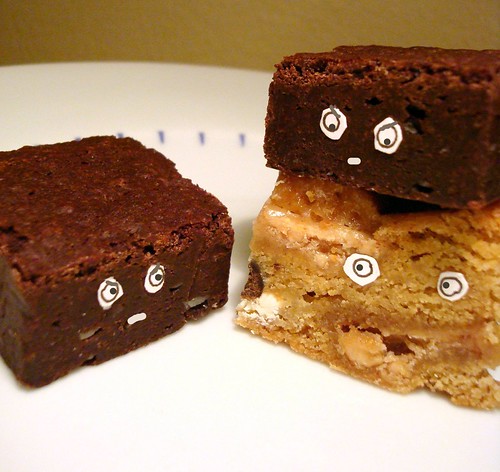
When we recently polled Cakespy readers on which iconic bar they preferred, the blondie or the brownie, we found the results staggering: out of our respondents, 174 vs 49 preferred the brownie.
Now, we understand why brownies ought to be loved. They're soft. They're gooey. They take to a variety of fillings. But are they really so superior to the blondie? Surely, we figure, once people get to know the honey-hued confection they'll show a little more love--so, we took some time to get to know the blondie better, and share it here, so that our readers can see that while it may not be the same as a brownie, it sure ought to be loved:
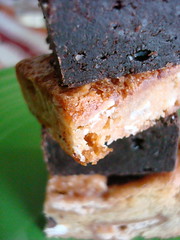 But first things first. What is a blondie? Generally, a blondie is accepted as a type of brownie--but not so much a brownie flavor, more like an identical cousin. An identical, albino cousin. Generally, it uses vanilla or butterscotch base instead of chocolate, and thus has a lighter hue which gives it its name. In our opinion, the finest blondies will have a texture (though not taste) halfway between a cakey and a fudgy brownie: that is to say, delightfully chewy, rich, and dense.
But first things first. What is a blondie? Generally, a blondie is accepted as a type of brownie--but not so much a brownie flavor, more like an identical cousin. An identical, albino cousin. Generally, it uses vanilla or butterscotch base instead of chocolate, and thus has a lighter hue which gives it its name. In our opinion, the finest blondies will have a texture (though not taste) halfway between a cakey and a fudgy brownie: that is to say, delightfully chewy, rich, and dense.
But whatever you may call a blondie, don't call it a brownie wannabe. For as we discovered on foodtimeline.org:
According to old cookbooks, blonde brownies (also known as "Blondies") predated chocolate brownies, though under different names. The primary ingredients of blondies (brown sugar/molasses and butter) compose butterscotch, a candy that was popular in America in the mid-19th century. Some 19th century American cookbooks contain recipes that combined traditional butterscotch ingredients with flour and a leavening agent (baking powder or soda). Presumably, these recipes would have produced something similar to the blonde brownies we enjoy today.
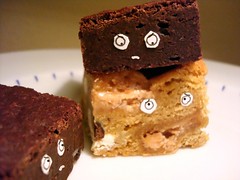 Furthermore, aforementioned recipes are thought to be descendants of gingerbread cakes which dated back to Renaissance times, which eventually evolved to cakes which were baked in shallow pans and included nuts and brown sugar.
Furthermore, aforementioned recipes are thought to be descendants of gingerbread cakes which dated back to Renaissance times, which eventually evolved to cakes which were baked in shallow pans and included nuts and brown sugar.By the 1950s, butterscotch or vanilla brownies were described as "blonde brownies," underscoring the primacy of chocolate.Aren't you starting to feel a little bit for the dear blondie now?
Blondies, the taste of chocolate chips in: Because of the lack of chocolate in the base, it is our opinion that the addition of chocolate chips is better appreciated in the blondie--while we certainly wouldn't say they detract from a brownie's taste (oh, not at all), the contrasting flavor that they add to the blondie's mellow butterscotch taste is beyond compare, each little chocolatey morsel a pleasant surprise and miniature treasure for the tastebuds.
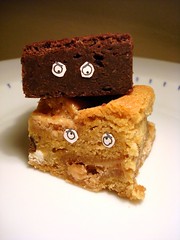 Blondies, lack of frosting atop: With brownies, it seems as though there are two primary types--dense, fudgy, moist brownies, which usually remain unfrosted--and more cakey, slightly fluffier versions, which sometimes have frosting. As much as we love frosting, we have to admit that some frosted brownies make us just a little bit suspicious--like they've got something to hide perhaps? However, we have never before seen a frosted blondie. Naturally, the only conclusion to be drawn is that our dear blondies have nothing to hide. (Cakespy Note: Naturally, when we make some bold statement soon about how everything benefits from the addition of frosting, we expect to be called hypocrites).
Blondies, lack of frosting atop: With brownies, it seems as though there are two primary types--dense, fudgy, moist brownies, which usually remain unfrosted--and more cakey, slightly fluffier versions, which sometimes have frosting. As much as we love frosting, we have to admit that some frosted brownies make us just a little bit suspicious--like they've got something to hide perhaps? However, we have never before seen a frosted blondie. Naturally, the only conclusion to be drawn is that our dear blondies have nothing to hide. (Cakespy Note: Naturally, when we make some bold statement soon about how everything benefits from the addition of frosting, we expect to be called hypocrites).
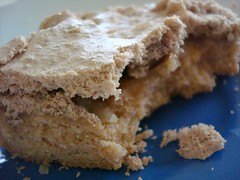 If it sounds good to you to have blondies that are "denser than chocolate chip cookies, more complex than brownies and in the classic Minimalist style" that you can "customize anywhere from a cranberry almond coconut bar to...gunky atery-cloggers"...then it sounds like you'd better check out this one by Smitten Kitchen.
If it sounds good to you to have blondies that are "denser than chocolate chip cookies, more complex than brownies and in the classic Minimalist style" that you can "customize anywhere from a cranberry almond coconut bar to...gunky atery-cloggers"...then it sounds like you'd better check out this one by Smitten Kitchen.
